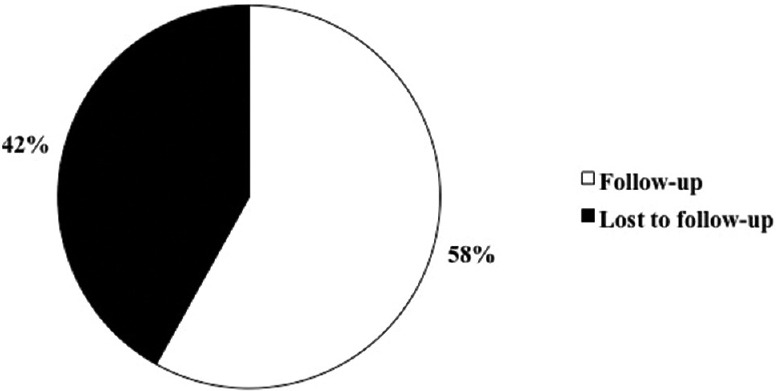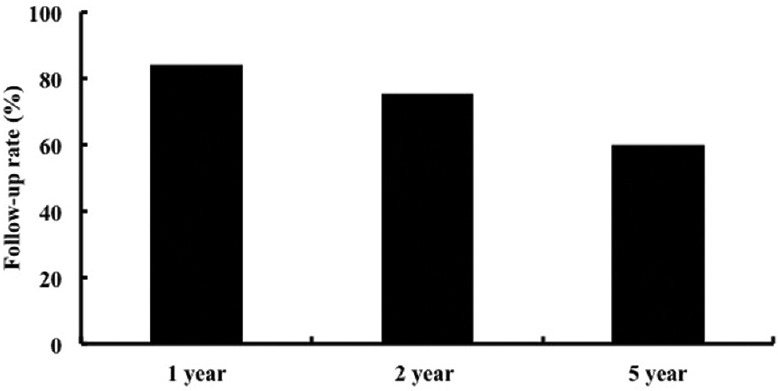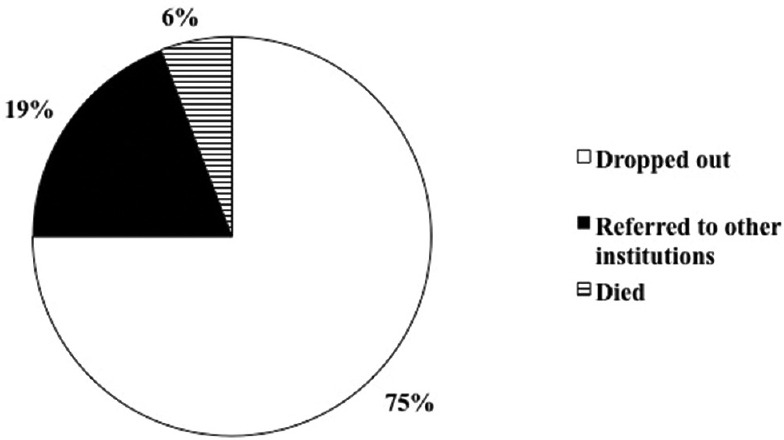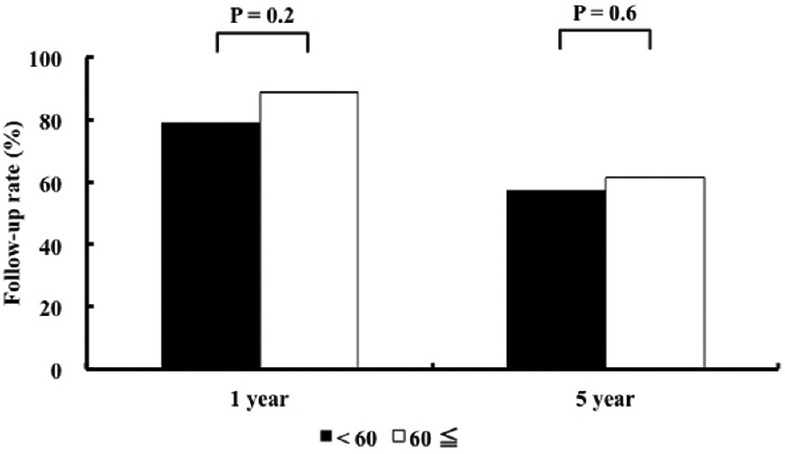Abstract
Long-term follow-up of kidney donors is needed not only for the individual donor's benefit but also to establish analyzable databases to improve the selection criteria for future donors. We collected data including the date of transplantation, the date of the last follow-up, donor's age, sex, their relationship to the recipient, renal function, proteinuria, and the prevalence of hypertension. Of 124 donors, 52 donors were not being followed up. The mean duration of follow-up was 4.3 ± 3.6 years. Follow-up rates were 83.9%, 74.6%, and 59.2% at 1 year, 2 years, and 5 years postdonation, respectively. Of those not being followed up, 75% dropped out. Follow-up rates did not differ between parent and spouse donors 5 years (57.1% vs. 71.4%; P = 0.4) postdonation. Similarly, follow-up rates at 5 years did not differ between donors aged 60 years or older and those younger than 60 (57.5% vs. 61.3%; P = 0.6). Of 72 donors being followed up, 75.0% had estimated glomerular filtration rate of <60 mL/min/1.73 m2, 8.3% had proteinuria, and 41.7% had hypertension requiring medication. There is a limitation to the endeavor of each transplant center to follow-up all their donors. Long-term donor follow-up in Japan requires a national registration system and mandates transplant center participation.
Keywords: Japan, living kidney donor, transplantation
Introduction
Long-term follow-up of donors has been advocated not only for the individual donor's benefit but also to establish analyzable databases to improve the selection of future donors.[1] The long-term safety of a living donation has been reported in young, healthy, Caucasian kidney donors.[2] In Japan, besides the racial difference, the proportion of medically complex donors, such as those of advanced age or with hypertension is greater. There is a need for data on long-term outcomes in such donors. To date, there are only a few single-center reports from Japan about long-term outcomes of living donors.[3,4] Most donors are lost to follow-up. In this study, we evaluated the long-term consequences of kidney donation, including the follow-up rates in our center.
Materials and Method
Between January 1990 and December 2013, a total of 124 living donor kidney transplants were performed. The data including the date of transplantation, the date of the last follow-up, donor's age, sex, their relationship to the recipient, kidney function, proteinuria, and the prevalence of hypertension were collected, reviewing the respective medical charts. Donors were assessed on whether they were currently followed up or not. Being followed up was defined as either having clinic visits within a year or future appointments. Of those not being followed up, the status of those donors was assessed, and they were divided as a dropout, referred to other institutions, or died. We assessed whether there was a difference in the follow-up rates depending on the relationship of the donor to the recipient or the age of the donor. We also assessed the donor outcomes in terms of their kidney function, proteinuria, and the prevalence of hypertension. The new equation proposed by the Japanese Society of Nephrology was used to calculate the estimated glomerular filtration rates (eGFRs), as follows: eGFR = 194 × (creatinine) −1.094 × age −0.287 (or × 0.739 if female).[5] The Research Ethics Board of our institution approved this study, and the research was conducted in accordance with the ethical standards of the Helsinki Declaration.
Statistical techniques
We used Chi-square and Fisher exact tests for categorical data and Student's t-test variance for continuous data. Values were expressed as a mean ± standard deviation, unless otherwise specified. P < 0.05 was considered to be statistically significant. Statistical analyses were conducted using SPSS version 16 (SPSS Inc., Chicago, IL, USA).
Results
Donor characteristics are summarized in Table 1. The mean age of the donors at the time of donation was 57.6 years (standard deviation: 10.5), and 74 (59.6%) of them were women. The mean follow-up duration was 4.3 (3.6) years. When donors were categorized as parents, spouses, brothers or sisters, and others, in terms of their relationship to the recipients, most of the donors were either parents (57.2%) or spouses (28.2%). Of 124 donors, 52 donors (41.9%) were not being followed up [Figure 1]. Follow-up rates were 83.9%, 74.6%, and 59.2% at 1 year, 2 years, and 5 years postdonation, respectively [Figure 2]. Of those not being followed-up, only 10 donors (19.2%) were referred to other institutions and most of them (75.0%) dropped out [Figure 3]. Two donors had died, one of traffic accident and the other of colon cancer. Follow-up rates between parent and spouse donors did not differ at 1 year (83.1% vs. 88.6%; P = 0.5) and 5 years (57.1% vs. 71.4%; P = 0.4) postdonation [Figure 4]. When donors were categorized according to age, 61 donors (49.2%) were aged 60 years or older, and 63 donors (50.8%) were younger than 60 years old [Table 1]. Follow-up rates did not differ between donors aged 60 years or older and those younger than 60 at 1 year (79.4% vs. 88.5%; P = 0.2) and 5 years (57.5% vs. 61.3%; P = 0.6) postdonation [Figure 5]. Of 72 donors being followed up, 75.0% (n = 54) had eGFR of <60 mL/min/1.73 m2 and their mean eGFR was 52.9 ± 10.2 mL/min/1.73 m2 [Table 2]. Similarly, 8.3% (n = 6) had a significant proteinuria defined as the presence of urinary protein exceeding 0.3 g/24 h or 0.3 g/gCr and 41.7% (n = 30) had hypertension requiring medication.
Table 1.
Baseline characteristics of the donors

Figure 1.

Follow-up rates of donors
Figure 2.

Follow-up rates of donors at 1 year, 2 year, and 5 years postdonation
Figure 3.

Details of donors not being followed-up
Figure 4.

Follow-up rates of parent and spouse donors at 1 year and 5 years postdonation
Figure 5.

Follow-up rates of donors aged 60 years or older and those younger than 60 at 1 year and 5 years postdonation
Table 2.
Baseline characteristics of the donors being followed-up

Discussion
Donor safety is the fundamental principle of living donor kidney transplantation, which is performed with the acceptable safety of kidney donors in mind. The long-term safety of donors postdonation has recently been documented in several reports.[2,6,7] On the other hand, there definitely are donors who develop significant proteinuria or declined renal function corresponding to chronic kidney disease (CKD; stage 3 or higher), and end-stage renal disease (ESRD) after donation.[8] Incidence of ESRD in living kidney donors has been reported to be 0.7%[3] with a median time of 20 years from donation to ESRD.[9] Thus, not only the recipients but also the donors need to be followed up for a long time.
Currently, donors are not followed up in most transplant centers in Japan. Likewise, there was no national registry for donor follow-up, making it difficult to report on the long-term outcomes of living donors. Our center is one of the few centers in Japan that have strongly encouraged donors to be followed up at their own institution to avoid being lost to follow-up. In this study, we evaluated the follow-up rates of living kidney donors in our center. The 5-year follow-up rate of 59.2% at our center was much better than that of a previous report from Japan, which reported a 5-year follow-up rate of 21.3%.[8] In this study, we confirmed that there is a wide difference in the actual follow-up rates between transplants centers. The higher follow-up rate at our center is probably because we strongly encourage annual clinic visits and laboratory checks for donors.
It is a matter of concern that only one-fifth of those not being followed up were referred to other institutions. The rest were lost to follow-up. Furthermore, once donors were referred to other institutions, data on blood pressure and kidney function were rarely received at the transplant center. In the United States, more than half of the programs never received any data from primary care physicians.[10] Only 5% of the programs received data on 75% or more of their donors from primary care physicians.[10] This suggests that there are limitations to the endeavors of transplant centers to follow-up all their donors and makes it reasonable to establish a national registry for donor follow-up.
Follow-up rates did not differ between parent and spouse donors, 1 year and 5 years postdonation, respectively [Table 1]. Similarly, follow-up rates did not differ between donors aged 60 or older and those younger than 60, 1 year and 5 years postdonation. We expected that spouse donors would have better follow-up rates as they usually live with their recipients who regularly attend transplant clinics after kidney transplants. We also expected that older donors would have better follow-up rates as most of them are retired with more free time and they typically have a stronger interest in their health than the younger generation. Our results showed that equally strong education is needed in these subgroups to prevent them from getting lost to follow-up.
Most of the donors in Japan are known to develop CKD stage 3 after donation.[11,12] In our study, 75.0% of the donors had eGFR of less than 60 mL/min/1.73 m2 and classified as CKD stage 3. 8.3% had a significant proteinuria, and 41.7% had hypertension requiring medication, which were similar to previous reports.[2] Although kidney donors convey minimal risk of ESRD in the absence of any other markers of kidney disease, some donors do develop risk factor of CKD and require close follow-up.
There are a number of barriers to providing long-term donor follow-up. The most commonly reported barrier is donor inconvenience. Cost issues are also common. Donors often consider themselves healthy and stop visits to the clinic by their own judgment.[8] For these reasons, many physicians involved in the care of living kidney donors have encountered difficulties in providing long-term care.
Although living kidney donation is common, substantial variation exists between transplant programs with regard to how a potential donor is screened and which exclusion criteria are used. More widespread and long-term follow-up of living donors would provide important registry data. These data would ultimately improve the evaluation of potential living donors, especially those who are medically complex.
All donors should be followed up continuously, at least once a year, but more often, especially if they are at risk of CKD progression. They should be carefully checked not only for the decline of renal function but also for the development of any new risks of CKD or cardiovascular disease, which subsequently need to be managed.
Financial support and sponsorship
Nil.
Conflicts of interest
There are no conflicts of interest.
References
- 1.Mandelbrot DA, Pavlakis M, Danovitch GM, Johnson SR, Karp SJ, Khwaja K, et al. The medical evaluation of living kidney donors: A survey of US transplant centers. Am J Transplant. 2007;7:2333–43. doi: 10.1111/j.1600-6143.2007.01932.x. [DOI] [PubMed] [Google Scholar]
- 2.Ibrahim HN, Foley R, Tan L, Rogers T, Bailey RF, Guo H, et al. Long-term consequences of kidney donation. N Engl J Med. 2009;360:459–69. doi: 10.1056/NEJMoa0804883. [DOI] [PMC free article] [PubMed] [Google Scholar]
- 3.Okamoto M, Akioka K, Nobori S, Ushigome H, Kozaki K, Kaihara S, et al. Short-and long-term donor outcomes after kidney donation: Analysis of 601 cases over a 35-year period at Japanese single center. Transplantation. 2009;87:419–23. doi: 10.1097/TP.0b013e318192dc95. [DOI] [PubMed] [Google Scholar]
- 4.Yasumura T, Nakai I, Oka T, Ohmori Y, Aikawa I, Nakaji K, et al. Experience with 247 living related donor nephrectomy cases at a single institution in Japan. Jpn J Surg. 1988;18:252–8. doi: 10.1007/BF02471441. [DOI] [PubMed] [Google Scholar]
- 5.Matsuo S, Imai E, Horio M, Yasuda Y, Tomita K, Nitta K, et al. Revised equations for estimated GFR from serum creatinine in Japan. Am J Kidney Dis. 2009;53:982–92. doi: 10.1053/j.ajkd.2008.12.034. [DOI] [PubMed] [Google Scholar]
- 6.Najarian JS, Chavers BM, McHugh LE, Matas AJ. 20 years or more of follow-up of living kidney donors. Lancet. 1992;340:807–10. doi: 10.1016/0140-6736(92)92683-7. [DOI] [PubMed] [Google Scholar]
- 7.Haberal M, Karakayali H, Moray G, Demirag A, Yildirim S, Bilgin N. Long-term follow-up of 102 living kidney donors. Clin Nephrol. 1998;50:232–5. [PubMed] [Google Scholar]
- 8.Kido R, Shibagaki Y, Iwadoh K, Nakajima I, Fuchinoue S, Fujita T, et al. How do living kidney donors develop end-stage renal disease? Am J Transplant. 2009;9:2514–9. doi: 10.1111/j.1600-6143.2009.02795.x. [DOI] [PubMed] [Google Scholar]
- 9.Fehrman-Ekholm I, Nordén G, Lennerling A, Rizell M, Mjörnstedt L, Wramner L, et al. Incidence of end-stage renal disease among live kidney donors. Transplantation. 2006;82:1646–8. doi: 10.1097/01.tp.0000250728.73268.e3. [DOI] [PubMed] [Google Scholar]
- 10.Mandelbrot DA, Pavlakis M. Living donor practices in the United States. Adv Chronic Kidney Dis. 2012;19:212–9. doi: 10.1053/j.ackd.2012.04.010. [DOI] [PMC free article] [PubMed] [Google Scholar]
- 11.Kido R, Shibagaki Y, Iwadoh K, Nakajima I, Fuchinoue S, Fujita T, et al. Very low but stable glomerular filtration rate after living kidney donation: Is the concept of “chronic kidney disease” applicable to kidney donors? Clin Exp Nephrol. 2010;14:356–62. doi: 10.1007/s10157-010-0279-y. [DOI] [PubMed] [Google Scholar]
- 12.Saito T, Uchida K, Ishida H, Tanabe K, Nitta K. Changes in glomerular filtration rate after donation in living kidney donors: A single-center cohort study. Int Urol Nephrol. 2015;47:397–403. doi: 10.1007/s11255-014-0861-4. [DOI] [PubMed] [Google Scholar]


